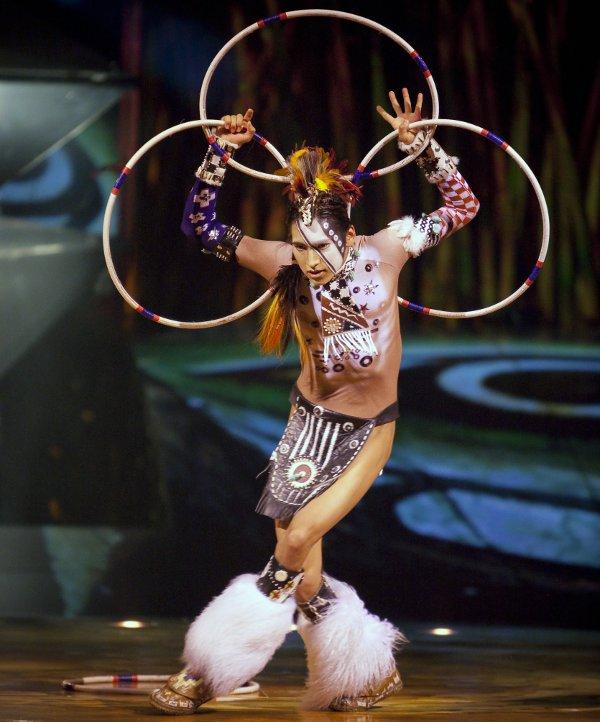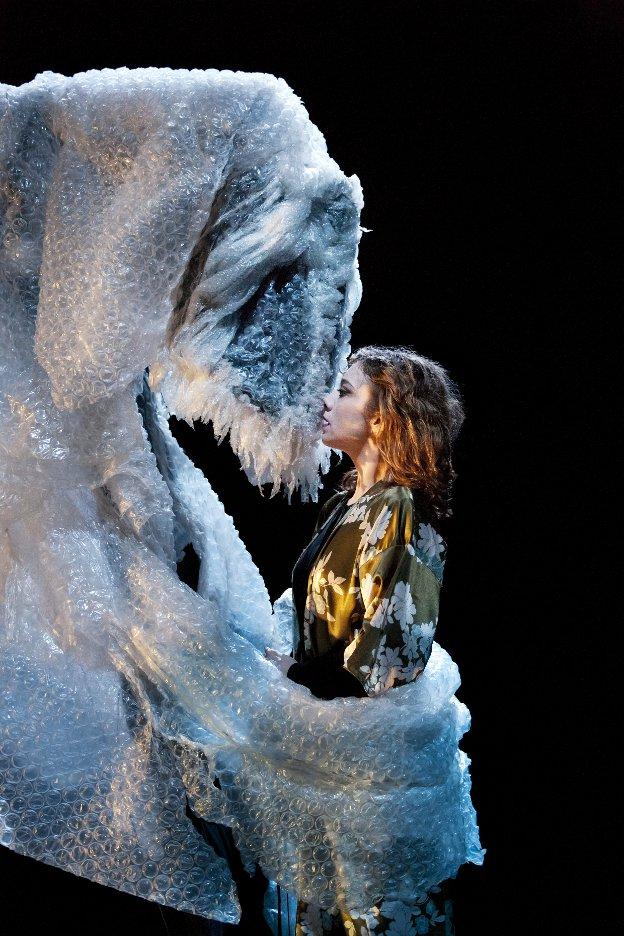Circus and narrative: discuss.
Of course, a regular linear narrative is not at all necessary in circus. Circus is, traditionally, a series of acts, including aerial of all kinds, balancing acts using various devices, object manipulation of one sort or another, and sundry ‘specialist’ things like dance numbers or magic acts (or in old-school circus, animal acts) – with the clowns there to provide the glue to fill the gaps and to give space and time for the riggers to shift the kit. There can be a theme or some kind of overarching aesthetic that unites the show – but the acts don’t need to fit in with or tell a story.
So here’s the dilemma with circus-theatre: how to fit the narrative in with the acts. If a narrative is set up yet isn’t developed, then it is far more irritating and unsatisfying than no narrative. Cirque du Soleil’s Totem, their second collaboration with compatriot Robert Lepage, promises much but delivers very little in the way of engaging circus-theatre – although if we strip away the ‘theatre’ part of the equation, then there are some jolly good circus acts (as we’d expect of this world-renowned company).
The show is written and directed by Lepage (although Cirque have an extraordinarily large team of ‘creative directors’ and ‘artistic directors’ of various sorts on board too, so who knows who contributed what in reality!) and purportedly tells the story of the evolution of mankind, with the programme notes giving a reflection from Lepage on a human baby’s personal journey from watery womb to land, and from earth-bound rocking and crawling to upright walking and aspirations into the air – thus setting up a parallel between personal evolution and species evolution. This is a potentially interesting theme that is touched on but not properly developed in the show, which instead gives us scenes celebrating some sort of primeval/elemental ‘birth-of-life’ moment followed by a very superficial exploration of man’s conquering of nature, which mostly boils down to numerous comic reflections on water sports and activities (fishing, surfing, water-skiing) or cod-batty professor battles with the elements, or ‘suits’ go walkabout in the jungle skits. The clowning and physical theatre element generally is of a pretty average quality, with many of the scenes far too long – which is disappointing as past Cirque du Soleil shows have featured some wonderful clown and mime work.
There’s an oddly uncomfortable celebration of the noble savage and, bizarely, it all reminds me of the Millennium Dome Show of ten years past. Something to do with the upmarket hippy cultural patchwork aesthetic, multi-coloured ‘ethnic’ costumes, and everything-in-the-pot stew of ‘world music’ influences.
The one clear Lepage signature is the design of the set’s centrepiece, a kind of ‘island’ (backed by waving reeds that hide the live orchestra) upon which film is projected, thus very cleverly and effectively transforming a large area of the stage into river, swamp or sea as needed, with some neat screen-to-live moments (moving image swimmers become real people etc). At times this ‘island’ opens, closes and shape-shifts like a giant Transformer toy. In front of it is a large turtle-shaped construction (a nod towards Native American creation myths), its ‘skin’ coming off to reveal a bony structure used to dangle from or into, or flip over and through.
Some of the acts could be shoe-horned into the ‘evolution’ narrative reasonably successfully, such as the above-mentioned opening bars and trampoline act in and around the ‘turtle’, which denotes the nascent human beings’ rise to the vertical and emergence from the caves. Later, the age of enlightenment is represented rather nicely in a scene in which juggler Greg Kennedy in mad scientist mode manipulates LED balls within a Steampunk-style glass contraption, whilst a monkey in a lab coat looks on.
It’s really hard to fathom out, though, what the roller-skating duet (wonderful though they were – indeed, one of my favourite acts), or the Chinese all-lady unicycling and bowls-juggling team, had to do with anything, narratively speaking – even though technically excellent and artistically appealing. The foot jugglers similarly seemed out on a limb (so to speak) both thematically and narratively. In fact, they looked liked they’d just been airlifted in from the Moscow State Circus – space-age sparkly costumes and all. And I have to admit that whatever might be manipulated (balls, logs or, as in this case, cloths) foot juggling always seems to me to be – well, just what it is – and it doesn’t really rock my boat. A Perches act (climbing and balancing on flexible poles) is good but marred by over-reliance on tautly pulled harness support, so it all seems a bit too safe, with little sense of the daring thrill of it all.
Free of harnesses, and the best act of the evening, is a doubles static trapeze piece by French-Canadians Louis-David Simoneau and Rosalie Ducharme, who trained at Montreal’s acclaimed National Circus School. It’s an exploration of a romantic entanglement (par for the course for aerial doubles!), but with a different edge as they act out the irritations, exasperations and rapprochements of a relationship. Their routine has a gorgeous pace and rhythm as they twist and squirm towards and away from each other, moving from elegance to feigned awkwardness and back again. The Russian Bars act is also top-notch – an exhilarating and free-flying finale to the evening. Androgynous flyer Nikita Moiseev is particularly enchanting.
Ultimately, though, the pace of the show is slack, and the structure weak, with too much in the way of filler (those dull clowns), and far too much object manipulation (bearers of balls, bowls, devil sticks, and hoops seem ever-present – not to mention those Crystal Lady antipodists).
Given that the story is pretty meaningless, the pace and energy and general wow factor would need to be high to raise the show above its narrative failings – and Totem doesn’t really manage this. I think it is fair to say that it is not one of the better Cirque du Soleil shows.










